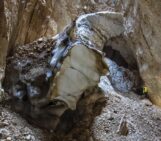
In a departure from the usual posts we feature on the blog, today Conor Purcell (a freelance science writer) brings you a thought provoking science fiction piece. Grab a drink and dive into this geology inspired adventure!
“It’s typical geology for a rocky planet” K reported. “Captured beneath the ocean at its northern pole, the core is a mix of metamorphic and sedimentary rock, with sand and fossilized organisms of the non-intelligent form. Nothing unusual.”
“We should use our new systems for this analysis,” It thought to itself. “Best to begin with a rocky planet.” K was the collective thinking entity of its group, a unified consortium of representatives now located across interstellar space: their task to find intelligent life beyond itself.
Here, on the orbiting cube, lying lengthways in front of K, and secured within the hold of the onboard core analyser, was a long cylindrical section – a core – of rock and mud which had been excavated from the planet below. K was now beginning the routine inspection performed on each of the cores acquired across the surveyed planets.
“Inspect all elements and produce time-series of environmental parameters relevant for the planet” K commanded itself.
It was then that something unusual triggered a notification in its Thought Centre – something it had never experienced. “What is this?” it asked.
For millennia, K had been searching for evidence of intelligent life on exoplanets beyond its own host star. In earlier times ground based receivers had been constructed and used to scour the endless black sky, and although life had been discovered to exist almost everywhere, without exception it took the form of mindless cellular or multicellular organisms. No trace of another Type 1 civilization had ever been found. Even as K’s technology advanced, observing and measuring the atmospheres of millions of remote planets to seek out the signatures of machine and biological life, and now even visiting those remote worlds, no sign of intelligence had yet been discovered.
What now caught the attention of K’s Thought Centre was a narrow section of fine material which appeared to have been laid down in a remarkably short period of time, during just twenty solar orbits. “This geology is unique,” K thought.
“On a planet that contains layers stacked typically over tens of thousands or millions of years, what kind of mechanism could produce such a pattern?” it asked itself. “A rapid fluvial event could produce something like this” it responded. “But not exactly: the material here is far too fine to be explained by known terrestrial, oceanic or atmospheric forces in the universe,” it thought. K could not explain it.
Far below the orbiting cube on which the analysis was being performed, over extensive distances from the poles to the equatorial belt, the K machines proceeded to core their way across the planet. For a rocky sphere of this size, two hundred cores would be drilled and sampled. The complete process would take a little over one solar orbit.
“What do we think about this anomaly?” K asked itself. “We should compute an age model for the section.”
“The section in question is relatively young, just 2.167 million solar orbits in age” it calculated. “It is wedged at the intersection between two geological epochs, marked by a large (25 degrees Kelvin) and incredibly rapid (300 years) temperature increase across the transition.”
K next extracted a sample from each of the section’s annually laid sediments and instructed itself to begin the weighing of trace elements. Chemical analysis of the ratios of isotopes would spell out a varying signal across time, detailing past temperatures and planetary ice volume. This kind of varying palaeoclimate history had been discovered on planets throughout the galaxy. It was ubiquitous.
But, amazingly, unlike the millions of geological cores previously processed, this short section presented no ordinary signal: the pattern generated by the weight of these trace elements was encrypted.
K had not seen anything like it before and inside its Thought Centre an alert was raised: no signal in the known universe had ever been found encrypted.
“Perform an analysis on the encryption, decipher, and display results,” K commanded.
“The signal has been encrypted using a very basic cypher, and can be unravelled easily.”
The deciphering took just microseconds, and right there and then the signal was laid bare, changing K’s understanding of the universe forever.
After millennia of exploration, believing it was the lone thinking entity in the universe, here was evidence conveying the existence of another intelligence, a message sublimely detailed in the universal language of mathematics. It read:
‘This was once an inhabited place which we called Earth.’
By Conor Purcell Science & Nature Writer with a PhD in Earth Science
Conor Purcell is a Science & Nature Writer with a PhD in Earth Science. He can be found on twitter @ConorPPurcell and some of his other articles at cppurcell.tumblr.com.



